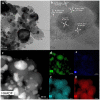Oxygen Vacancy Mediated Band-Gap Engineering via B-Doping for Enhancing Z-Scheme A-TiO2/R-TiO2 Heterojunction Photocatalytic Performance
- PMID: 36903674
- PMCID: PMC10005070
- DOI: 10.3390/nano13050794
Oxygen Vacancy Mediated Band-Gap Engineering via B-Doping for Enhancing Z-Scheme A-TiO2/R-TiO2 Heterojunction Photocatalytic Performance
Abstract
Fabrication of Z-scheme heterojunction photocatalysts is an ideal strategy for solving environmental problems by providing inexhaustible solar energy. A direct Z-scheme anatase TiO2/rutile TiO2 heterojunction photocatalyst was prepared using a facile B-doping strategy. The band structure and oxygen-vacancy content can be successfully tailored by controlling the amount of B-dopant. The photocatalytic performance was enhanced via the Z-scheme transfer path formed between the B doped anatase-TiO2 and rutile-TiO2, optimized band structure with markedly positively shifted band potentials, and the synergistically-mediated oxygen vacancy contents. Moreover, the optimization study indicated that 10% B-doping with the R-TiO2 to A-TiO2 weight ratio of 0.04 could achieve the highest photocatalytic performance. This work may provide an effective approach to synthesize nonmetal-doped semiconductor photocatalysts with tunable-energy structures and promote the efficiency of charge separation.
Keywords: Z-scheme heterojunction; anatase TiO2/rutile TiO2; band structure; oxygen vacancy.
Conflict of interest statement
The authors declare no conflict of interest.
Figures









References
-
- Chen X., Chen Q., Jiang W., Wei Z., Zhu Y. Separation-Free TiO2-Graphene Hydrogel with 3D Network Structure for Efficient Photoelectrocatalytic Mineralization. Appl. Catal. B Environ. 2017;211:106–113. doi: 10.1016/j.apcatb.2017.03.061. - DOI
-
- Deng Y., Xing M., Zhang J. An Advanced TiO2/Fe2TiO5/Fe2O3 Triple-Heterojunction with Enhanced and Stable Visible-Light-Driven Fenton Reaction for the Removal of Organic Pollutants. Appl. Catal. B Environ. 2017;211:157–166. doi: 10.1016/j.apcatb.2017.04.037. - DOI
-
- Ding Y., Yang I.S., Li Z., Xia X., Lee W.I., Dai S., Bahnemann D.W., Pan J.H. Nanoporous TiO2 Spheres with Tailored Textural Properties: Controllable Synthesis, Formation Mechanism, and Photochemical Applications. Prog. Mater. Sci. 2020;109:100620. doi: 10.1016/j.pmatsci.2019.100620. - DOI
-
- Friedmann D., Hakki A., Kim H., Choi W., Bahnemann D. ChemInform Abstract: Heterogeneous Photocatalytic Organic Synthesis: State-of-the-Art and Future Perspectives. Chem. Inform. 2016;47:5391–5411. doi: 10.1002/chin.201649227. - DOI
Grants and funding
LinkOut - more resources
Full Text Sources
Miscellaneous

